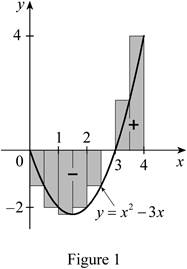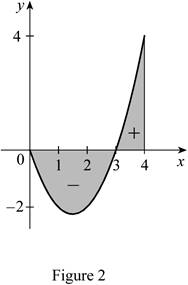
Concept explainers
a)
To find: an approximation to the integral
a)
Answer to Problem 26E
The approximation to the integral
Explanation of Solution
Given:
The integral function is,
The number of sub intervals as
The upper limit is 4 and lower limit is 0.
Theorem 4: If f is integrable on [a, b], then
Where
Calculation:
The integral function is,
The Riemann sum with right endpointsformula is,
Calculate the subinterval
Here, b is upper limit, a is lower limit, and n is number of subintervals.
Substitute 4 for b, 0 for a, and 8 for n.
Hence, the subinterval length is 0.5 for the limits
The subinterval values are 0.5, 1.0, 1.5, 2.0, 2.5,3.0, 3.5,and 4.0for
Calculate the approximation to the integral using a Riemann sum with right endpoints:
Substitute 0.5 for
Apply the subinterval values in Equation (3).
Consider
Calculate
Substitute 0.5 for x in Equation (4).
Calculate
Substitute 1.0 for x in Equation (4).
Calculate
Substitute 1.5 for x in Equation (4).
Calculate
Substitute 2.0 for x in Equation (4).
Calculate
Substitute 2.5 for x in Equation (4).
Calculate
Substitute 3.0 for x in Equation (4).
Calculate
Substitute 3.5 for x in Equation (4).
Calculate
Substitute 4.0 for x in Equation (4).
Substitute -1.25, -2.00, -2.25, -2.00, -1.25, 0.00, 1.75, and 4.00 for
Hence, the approximation to the integral
b)
To draw: a diagram similar to figure 3 to illustrate the approximation in part (a).
b)
Answer to Problem 26E
A diagram similar to figure 3 to illustrate the approximation in part (a) is drawn.
Explanation of Solution
Calculation:
Show the equation as below:
Plot a graph for the equation
Calculate y value using Equation (5).
Substitute 0 for x in Equation (5).
Hence, the co-ordinate of
Calculate y value using Equation (5).
Substitute 1 for x in Equation (5).
Hence, the co-ordinate of
Calculate y value using Equation (5).
Substitute 2 for x in Equation (5).
Hence, the co-ordinate of
Calculate y value using Equation (5).
Substitute 3 for x in Equation (5).
Hence, the co-ordinate of
Calculate y value using Equation (5).
Substitute 4 for x in Equation (5).
Hence, the co-ordinate of
Draw the region as shown in Figure 1.

c)
To evaluate: the integral
c)
Answer to Problem 26E
The evaluation of the integral
Explanation of Solution
Calculation:
The Theorem 4 is,
Calculate the subinterval
Here, b is upper limit, a is lower limit, and n is number of subintervals.
Substitute 4 for b, and 0 for a.
Calculate the
Substitute
The integral function is,
Apply the Theorem 4 in Equation (5).
Substitute
Hence, the evaluation of the integral
d)
To draw: a diagram similar to figure 4 to illustrate the integral in part (c) as a difference of areas.
d)
Answer to Problem 26E
A diagram similar to figure 4 to illustrate the integral in part (c) as a difference of areas is drawn.
Explanation of Solution
Calculation:
Draw the region as shown in Figure 2.

Refer Figure 2
Positive sign
The integral function is as follows:
Chapter 5 Solutions
Single Variable Calculus: Concepts and Contexts, Enhanced Edition
 Calculus: Early TranscendentalsCalculusISBN:9781285741550Author:James StewartPublisher:Cengage Learning
Calculus: Early TranscendentalsCalculusISBN:9781285741550Author:James StewartPublisher:Cengage Learning Thomas' Calculus (14th Edition)CalculusISBN:9780134438986Author:Joel R. Hass, Christopher E. Heil, Maurice D. WeirPublisher:PEARSON
Thomas' Calculus (14th Edition)CalculusISBN:9780134438986Author:Joel R. Hass, Christopher E. Heil, Maurice D. WeirPublisher:PEARSON Calculus: Early Transcendentals (3rd Edition)CalculusISBN:9780134763644Author:William L. Briggs, Lyle Cochran, Bernard Gillett, Eric SchulzPublisher:PEARSON
Calculus: Early Transcendentals (3rd Edition)CalculusISBN:9780134763644Author:William L. Briggs, Lyle Cochran, Bernard Gillett, Eric SchulzPublisher:PEARSON Calculus: Early TranscendentalsCalculusISBN:9781319050740Author:Jon Rogawski, Colin Adams, Robert FranzosaPublisher:W. H. Freeman
Calculus: Early TranscendentalsCalculusISBN:9781319050740Author:Jon Rogawski, Colin Adams, Robert FranzosaPublisher:W. H. Freeman
 Calculus: Early Transcendental FunctionsCalculusISBN:9781337552516Author:Ron Larson, Bruce H. EdwardsPublisher:Cengage Learning
Calculus: Early Transcendental FunctionsCalculusISBN:9781337552516Author:Ron Larson, Bruce H. EdwardsPublisher:Cengage Learning





